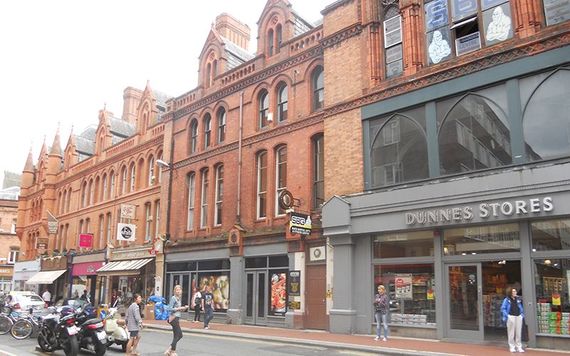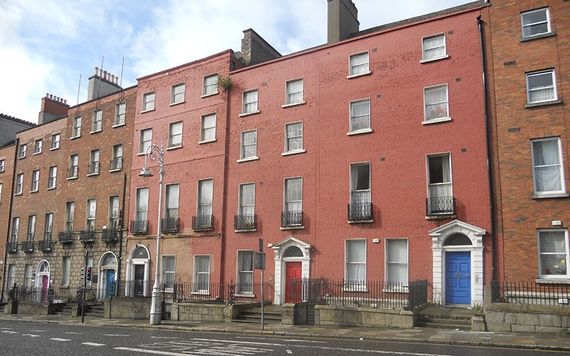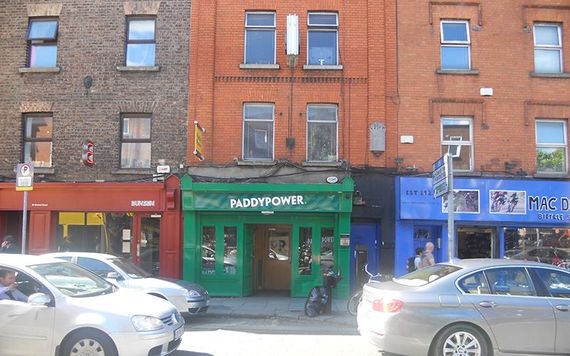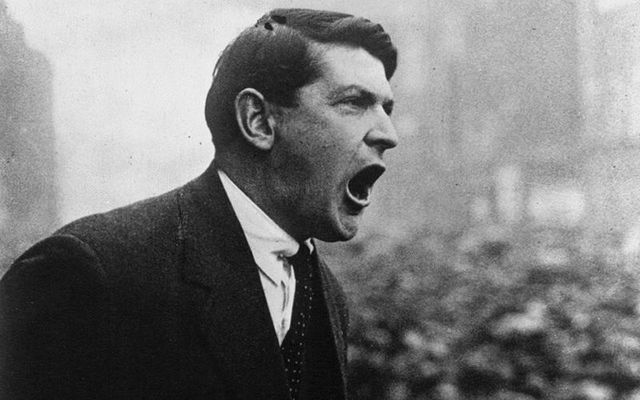Tales of swashbuckling drama and adventure in the Witness Statements of Michael O'Flanagan from an innocent fish shop in Wexford Street.
One of the great things the Irish government did in the late 1940s and early ’50s was to collect Witness Statements from those who participated in the War of Independence. These statements were stored at the Bureau of Military History. In anticipation of the centennial of the 1916 Easter Rising they were made available to the public and can be viewed for free here. They offer invaluable insights into the men, women and events that eventually led to the birth of the Irish Free State in 1921. Without them, the history of the Republic would have been much diminished.
Read more: Revealed - Michael Collins did not start Irish Civil War as widely believed
As I investigate various aspects of the Irish revolution I find myself returning again and again to the Bureau for information. Recently, I was reading about Father Michael O’Flanagan, vice president of Sinn Féin, and I was wondering if he had left a witness statement. At that time, I was unaware that Father O’Flanagan had died in 1942, years before the statements were collected. But I did come across another Michael O’Flanagan and his statement as an agent for Michael Collins is filled with drama and adventure, which could only be connected to the swashbuckling Irish Pimpernel, Collins himself.
This Michael O’Flanagan actually has two witness statements, both of which are very well written. They reveal a rich Fenian pedigree for him and his family. In the first statement he tells of his youth in Dublin—he was born in 1892 and lived in Moore Street—and his apprenticeship in the fish business. He was a supporter of James Larkin and lost his job in the in the great labor lockout of 1913. His job troubles forced him to emigrate to Glasgow, Scotland. It was there that he joined the Irish Volunteers and the Irish Republican Brotherhood (IRB). He was intimately involved in running guns and explosives back to Ireland in anticipation of the upcoming rising. With the police putting the heat on him, O’Flanagan decided to return to Dublin in November 1915. In his furniture, which was shipped back to Dublin with him, he hid explosives which he would turn over to the Countess Markievicz.
In his statement we run into many of the major actors of the Easter Rising: Tom Clarke, Ned Daly, Seán Heuston, Seán MacDiarmada, and Willie Pearse. O’Flanagan was assigned to the Four Courts under Commandant Daly. He was soon dispatched to North King Street in a rearguard action where he engaged the British in some of the heaviest street fighting of Easter Week. It was at this time that his brother, Patrick, was killed by British machine gun fire.
Read more: Stunning colorized video brings Irish hero Michael Collins to life
With the surrender O’Flanagan, like most of the rebels, found himself bivouacked in the Rotunda Hospital yard and then sent to Richmond Barracks, fingerprinted, and marched to a boat on the North Wall to be taken to England. He first stop was at Stafford Prison where he met a fellow by the name of Michael Collins. It was while being incarcerated here that O’Flanagan learned of the birth of his daughter in Dublin. He was then packed off to his final destination, Frongoch in Wales which became known as the “university of revolution.” He was among the first of the Frongoch rebels to be released in August 1916.
Settling in for guerilla warfare
Back in Dublin the revolution was taking a new turn under the tutelage of Collins. The time for open warfare with the British was over—surreptitious guerrilla warfare was the new tactic of the revolution.
Not surprisingly, O’Flanagan had trouble getting his job back with a fishmonger in Leeson Street. Like many rebels down on their luck, O’Flanagan turned to the National Aid Association at #10 Exchequer Street, which was run by Kathleen Clarke, widow of Tom. (She would soon turn over the reins to another ex-jailbird, one Michael Collins.) O’Flanagan was granted a £20 grant which set him up at his own fish shop in Wexford Street, not far from where Whelan’s well-know musical pub exists today.

#10 Exchequer Street, in Dublin (Via Dermot McEvoy).
Things were relatively quiet for O’Flanagan from 1916 through the general election in December 1918. During this time, he was still active in several IRB campaigns and acted as a military instructor for young Volunteers. Early in 1918 his shop was turned into a “dump” for arms and explosives. The IRA used “dumps” all over Dublin to hide, or dump, their arms and explosives. O’Flanagan’s experience running ordinance from Glasgow to Dublin made him a perfect choice for this new occupation. O’Flanagan also was charged with hiding such prominent rebels as Dan Breen, Seán Treacy and Seamus Robinson, all three “on the run” from Tipperary.
Intelligence work
In the middle of 1920, at the height of the war between Michael Collins’ Twelve Apostles and the British Secret Service, O’Flanagan was summoned by Collins for a meeting. As Director of Intelligence of the IRA, information meant everything to Collins. The more intelligence Collins could gather the easier it was for him and his commanders in the countryside to deal with the British.
It was at this point that Collins turned to the fishmonger of Wexford Street for help. Let O’Flanagan tell you in his own words:
“In or about July or August 1920, I was sent for by Mick Collins whom I met in the Prince’s Bar in Prince’s Street. He told me that he was fully aware of my association and that of my family with the Movement and that he appreciated fully the good work which I was doing. He told me that it had been decided to select certain reliable business premises in the city for the reception of correspondence from country Units which it would be unsafe to transmit through the ordinary postal channels and that my business premises in Wexford Street had been one of those selected. He informed me that certain people would call on me from time to time and having satisfied themselves that I was Michael O’Flanagan they would give me letters and parcels for delivery to his office at Vaughan’s Hotel, Parnell Square, or as might be notified to me from time to time. From that date until my arrest on the 2nd December 1920, I received several letters and parcels for Collins which I delivered to him as arranged.”
Vaughan’s Hotel, Parnell Square (via Dermot McEvoy)
Revolution is good for the fish business
Luck had a lot to do with Collins and his intelligence work. Collins couldn’t believe his luck when the British asked O’Flanagan to become their fish vendor at the Portobello (now Cathal Brugha) Barracks in Rathmines. Here’s what O’Flanagan wrote about that adventure:
“Sometime in August 1920, I was visited by a British Army Sergeant from Portobello Barracks who asked me if I would tender for the supply of fish and poultry to the Sergeants’ Mess. As I was somewhat suspicious of this approach by a member of the British Garrison I contacted Collins and by arrangement I met him at 41 Parnell Square on the following Sunday. I informed him of the position and asked for directions as to what action I would take. He told me to write to the Sergeants’ Mess concerned and give them an estimate of my prices and if I was successful in obtaining the contract I was to accept it. This I did, and my estimate was accepted. Collins told me that once I had gained access to the Barracks I should use every opportunity, to pick up information with particular reference to the layout, the location of the different guards and any other information which I felt might be of use. I continued to supply fish and poultry to the Sergeants Mess until my arrest in December 1920, and any information which came into my possession which I felt might be of use I transmitted to Collins.”
Working in “The Dardanelles”
The most direct route for military convoys from Portobello Barracks to Dublin Castle was to come over the Grand Canal and move right down Camden, Wexford, Aungier and Georges Streets before making the turn at Dame Street to get to the Castle. Of course, these convoys became fodder for the IRA and their hand grenades. The British caught on fast and put chicken wire over their lorries. The IRA soon discovered that a fish hook solved that dilemma—and guerilla war heated up for the British. It got so hot that it reminded people of the great defeat the British had taken at the hand of the Turks in the Dardanelles in 1915 and thus this part of Dublin became “the Dardanelles.”
Michael O’Flanagan’s fish shop at this ultimate time of war became even more important. He wrote:
“At this particular time British Military and Police activity became intensified and resulted in the discovery of a number of I.R.A. dumps throughout the city. As a result of this activity General Headquarters decided to change the location of all dumps and in consequence my business became the storage dump for the arms and munitions of the 3rd Battalion area…Wexford Street and Camden Street were at that time known as ‘The Dardanelles,’ since the streets were narrow and British Military parties passing to and from were subjected to almost continuous attack. In consequence the demands upon my time in the issuing and receipt of arms for the attacking units of the I.R.A. were frequent.”

The original site of the fishmongers on Wexford Street Dublin. (via Dermot McEvoy).
The Fishmonger’s arrest
Bloody Sunday happened on November 21, 1920. Agents of Collins’ Squad executed 14 British Service Agents. After the initial shock the British turned the screws on the IRA and arrested anyone they could get their hands on. Michael O’Flanagan was one of these men. He remembers his capture:
“With the intensification of the war against the British military Forces and Black & Tans, my premises in Wexford Street was under constant observation by Secret Service agents and Detectives of the Dublin Metropolitan Police. In consequence General Headquarters felt that my continued occupation of the premises and its usefulness as a dump and accommodation address was over, and in November of that year I was told to go ‘on the run’ and hand over the running of my business to my wife. This I did. About four doors down (No. 10 Wexford Street) was occupied by a publican named Cole who was a particular friend of mine and whose premises had also been used as a dump and safe lodging for men ‘on the run’. I stopped in Cole’s for about a fortnight. Curfew was from 10 p.m. until dawn and as my eldest son had contracted pneumonia I could only get to see him during curfew hours. This was not very difficult as the distance between my business premises and Cole’s where I stayed was only a few yards and I could cross from one backyard into another and thereby gain access to my home. On the night of the 1st December while paying one of my many visits to my home the house was surrounded, raided, searched and I was arrested and conveyed to the Castle. During the course of the search the Officer in charge, who was a very courteous type, told me that if I wished to have a private conversation with my wife before being taken away he would raise no objection and would see that we would not be disturbed by any member of his party. I had four letters on me which I had received for delivery to Collins and I took the opportunity while the military had withdrawn from the room to give the letters into my wife’s possession. Nurse Treston, a sister-in-law of Sean McGarry and also a member of the Cumann na mBan who had been engaged in nursing my son during his illness, undertook to deliver the letters to Collins.”
Paddy Moran’s close shave costs him his life
The reason for the arrests of so many IRA men was that the British were out for revenge for Bloody Sunday. O’Flanagan was interrogated at Dublin Castle and later moved to Arbour Hill Military Barracks where the men of 1916 had been buried after their execution. The British were bringing in witnesses from the attacks on Bloody Sunday to view the men in lineups. The British ordered the men, who had been in custody for a while, to shave, but they refused, believing that having beards would help their chances of getting off. IRA captain Paddy Moran did not heed their advice:
“Sometime that morning,” O’Flanagan wrote, “I was removed to what was then known as ‘the condemned cell’ on the ground floor and confined in the cell with me was Paddy Moran who had been arrested on suspicion of being concerned in the Mount Street shootings on Bloody Sunday. There were also in the cell two others whom I knew—Kevin Halpin and Jim Lynch. After about ten days or a fortnight we were brought out on an identification parade within the Quadrangle of the prison. When we got there, we found that the windows of the wash-house had been covered with Army blankets in which slits had been cut. The passage-way leading to the wash-house was covered in a similar manner and the civilians who were being brought in to identify us used this passage-way to the wash-house so that they could not be observed by us. We were paraded round in front of the windows and kept facing them for about twenty minutes after which period we were returned to the hall of the prison. All four of us were wearing beards at the time of four days’ growth and the Commandant addressed us in the hallway and told us that we would have to remove our beards adding that he would supply us with the facilities to enable us to do so. I refused to do so, informing him that I came in with a beard and that I proposed to leave in that manner. In fact, I never shaved during the twelve months of my detention. Lynch and Halpin also refused to shave but Moran said to me that he had nothing to fear and that as far as he was concerned he would avail of the opportunity to do so. I advised Paddy Moran under no circumstances to shave as by doing so he would only make it easier for them to pin something on him, but despite my advice he shaved off his beard. I knew Paddy Moran for a considerable period and I knew of his association with the Movement. I was also aware that they had been after him for some time. There was a bit of a rumpus created by the military authorities in regard to our refusal to carry out their orders, but this simmered down and three of us—Halpin, Lynch and myself—were allowed to associate with our fellow-prisoners. Moran, however, having gone into the cell to shave was not allowed out to join us and I did not see him again. Following on our permission to associate with the remainder of our fellow-prisoners I went immediately to Joe McGrath who was then the Prisoners’ Commandant in Arbour Hill. I told him what had happened. I said I had advised Paddy Moran not to shave, adding that we had refused to do so. He told me we acted correctly and that it was a pity Paddy Moran had complied with the military request in this matter. I am satisfied that if Moran had refused to shave off his beard he would not have been identified and subsequently sentenced to death for his activities.”
Moran was sent for trial for the execution of two British Secret Service agents at 38 Upper Mount Street. He did not do the shootings. They were done by Vinny Byrne of the Squad. During the trial Moran was imprisoned at Kilmainham Gaol. He had the opportunity to escape with the legendary Ernie O’Malley and another man. He refused because he knew of his innocence. O’Malley duly escaped. Moran was found guilty and was hanged at Mountjoy Gaol in 1921. He is now remembered as one of the “Forgotten Ten.”
Rebel to the End
O’Flanagan was finally released from a Belfast prison in December 1921, but his rebel days were not over. He found himself at Beggars Bush Barracks when they were turned over to Michael Collins and the Free State government. This time he turned Collins down:
“It was on that occasion that he asked me if I was going to come into the Army. I told him that I had made up my mind to devote the remainder of my life to the welfare of my family as I felt I had given a good deal of service to the Cause of Independence in the past.”
But O’Flanagan was not done yet. Although he had great admiration for Collins he also had a lot of close friends on the anti-Treaty side and who were now occupying the Four Courts. Although he did not actively fight with the anti-Treaty forces, he did lend them the use of his automobile and ran some errands for them as Collins’ forces were bombarding the Courts in June 1922.
It was here that his service to Ireland ended. Michael O’Flanagan was right. He had contributed enough to the Cause of Independence.
Read more: The use of IEDs in the Irish War of Independence
* Dermot McEvoy is the author of the The 13th Apostle: A Novel of Michael Collins and the Irish Uprising and Our Lady of Greenwich Village, both now available in paperback, Kindle and Audio from Skyhorse Publishing. He may be reached at [email protected]. Follow him at www.dermotmcevoy.com. Follow The 13th Apostle on Facebook.




Comments